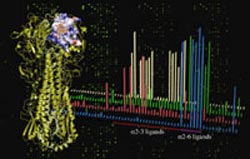New technique for detecting ability of flu viruses to infect humans

WHAT:
NIH-funded scientists at The Scripps Research Institute have developed a technique for detecting changes in flu viruses that would precede a virus’s ability to infect humans and cause epidemics. The new, publicly available tool, called a glycan array, could be used to monitor the emergence of flu strains that efficiently infect humans, including those of avian origin. The technology was developed by the Consortium for Functional Glycomics, a “glue grant” project sponsored by NIH’s National Institute of General Medical Sciences (NIGMS). The National Institute of Allergy and Infectious Diseases also funded the research.
WHY and WHEN:
“Glycoarray Analysis of the Hemagglutinins from Modern and Pandemic Influenza Viruses Reveals Different Receptor Specificities” by Ian Wilson, D.Phil., James Paulson, Ph.D., and their coworkers is scheduled to be published in the February 3, 2006 issue of the Journal of Molecular Biology. The article appeared online on November 18, 2005.
WHO:
Jeremy M. Berg, Ph.D., Director, National Institute of General Medical Sciences, is available to comment on the new technique and how it can be used to detect potentially dangerous flu strains. Berg can also discuss the NIGMS “glue grant” program, which brings together teams of scientists with diverse expertise to tackle complex problems that are of central importance to biomedical science.
Media Contact
All latest news from the category: Life Sciences and Chemistry
Articles and reports from the Life Sciences and chemistry area deal with applied and basic research into modern biology, chemistry and human medicine.
Valuable information can be found on a range of life sciences fields including bacteriology, biochemistry, bionics, bioinformatics, biophysics, biotechnology, genetics, geobotany, human biology, marine biology, microbiology, molecular biology, cellular biology, zoology, bioinorganic chemistry, microchemistry and environmental chemistry.
Newest articles

A universal framework for spatial biology
SpatialData is a freely accessible tool to unify and integrate data from different omics technologies accounting for spatial information, which can provide holistic insights into health and disease. Biological processes…

How complex biological processes arise
A $20 million grant from the U.S. National Science Foundation (NSF) will support the establishment and operation of the National Synthesis Center for Emergence in the Molecular and Cellular Sciences (NCEMS) at…

Airborne single-photon lidar system achieves high-resolution 3D imaging
Compact, low-power system opens doors for photon-efficient drone and satellite-based environmental monitoring and mapping. Researchers have developed a compact and lightweight single-photon airborne lidar system that can acquire high-resolution 3D…





















